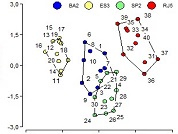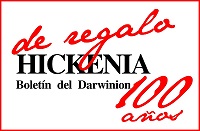Abordaje multivariado en estudios botánicos y ecológicos
DOI:
https://doi.org/10.14522/darwiniana.2023.111.1086Palabras clave:
Análisis de correspondencia, análisis discriminante, clasificación jerárquica, componentes principales, datos multivariados, escalamiento multidimensionalResumen
Interesantes estudios de botánica y ecología utilizaron un enfoque multivariado para describir patrones subyacentes en grandes conjuntos de datos. Mediante este abordaje lograron responder interrogantes acerca de la estructura de sistemas biológicos en diferentes escalas. Este trabajo se propone incentivar el uso correcto del enfoque multivariado y ofrecer pautas para la apropiada elección de las técnicas de análisis según los objetivos del estudio y las características de los datos. Contiene ejemplos de artículos publicados en revistas científicas con apropiadas aplicaciones de Componentes Principales, Escalamiento Multidimensional, Análisis de Correspondencia, Análisis Discriminante y Aglomeración Jerárquica. Utilizamos versiones reducidas de las matrices de datos de algunos de estos trabajos publicados para presentar de manera sencilla los métodos de análisis. El artículo pone en consideración las preguntas biológicas que los análisis multivariados permiten responder y la correcta interpretación de los resultados.
Citas
Batista, W.; A. Rolhauser, F. Biganzoli, S. Burkart, L. Goveto, A. Maranta, A. Pignataro, N. Morandeira & M. Rabadán. 2014. Las comunidades vegetales de la sabana del parque nacional El Palmar (Argentina). Darwiniana, nueva serie 2(1): 5-38. DOI: https://doi.org/10.14522/darwiniana.2014.21.569
Bonasora, M. G., M. T. Pozzobon, A. I. Honfi & G. H. Rua. 2015. Paspalum schesslii (Poaceae, Paspaleae), a new species from Mato Grosso (Brazil) with an unusual base chromosome number. Plant Systematics and Evolution 301: 2325-2339.
Burkart, S. E.; R. J. C. León, S. B. Perelman & M. Agnusdei. 1998. The grasslands of the flooding pampa (Argentina): Floristic heterogeneity of natural communities of the southern Rio Salado basin. Coenoses 13: 17-27.
Chaneton, E. J.; S. B. Perelman, M. Omacini & R. J. C. León. 2002. Grazing, Environmental Heterogeneity, and Alien Plant Invasions in Temperate Pampa grasslands. Biological Invasions 4: 7-24.
Chase, J. M. 2010. Stochastic community assembly causes higher biodiversity in more productive environments. Science 5984: 1388-1391.
Christodoulou, M. D.; J. Y. Clark & A. Culham. 2020. The Cinderella discipline: morphometrics and their use in botanical classification. Botanical Journal of the Linnean Society 194: 385-396.
Cué-Hernández, K. A., Gil-Muñoz, A., Aguirre-Jaimes, A., López P.A., & Rey Taboada-Gaytán, O. (2022). Floral visitors in the crop Phaseolus coccineus (Fabaceae) on the Altiplano of Puebla, Mexico: importance of agricultural management and flower color. Acta Botánica Mexicana 128: e1924. DOI: https://doi.org/10.21829/abm129.2022.2054
Digby, P. G. N. & R. A. Kempton. 1987. Population and Community Biology Series: Multivariate Analysis of Ecological Communities. Chapman and Hall, London.
Di Rienzo J. A.; F. Casanoves, M. G. Balzarini, L. Gonzalez, M. Tablada & C. W Robledo. InfoStat versión 2020. Centro de Transferencia InfoStat, FCA, Universidad Nacional de Córdoba, Argentina. https://www.infostat.com.ar
Ferrero, M. A.; A. B. Sassone, L. Giussani & A. S. Vega. 2020. Distribution models and morphometric analyses as additional tools for the study of diversification in Deyeuxia velutina, an Andean grass species. Darwiniana, nueva serie 8(2): 509-524. DOI: https://doi.org/10.14522/darwiniana.2020.82.894
Giussani, L. M.; E. G. Nicora & F. A. Roig. 2000. Poa durifolia and its relationship with the phenetic pattern of Poa section Dioicopoa (Poaceae). Darwiniana 38(1-2): 47-57. DOI: https://doi.org/10.14522/darwiniana.2000.381-2.161
Greenacre, M. 2013. The contributions of rare objects in correspondence analysis. Ecology 94: 241- 249.
Hill, M. O. & H. G. Gauch, Jr. 1980. Detrended Correspondence Analysis: an improved ordination technique. Vegetatio 42: 47-58.
Husson, F., S. Lê & J. Pagès. 2017. Exploratory Multivariate Analysis by Example Using R. 2nd edition. Chapman & Hall/CRC Computer Science & Data Analysis.
Jackson, D. A. & K. M. Somers. 1991. Putting things in order: the ups and downs of detrended correspondence analysis. American Naturalist 137: 704-712.
Kenkel, N. C.; D. A. Derksen, A. G. Thomas & P. Watson. 2002. Review: Multivariate analysis in weed science research. Weed Science 50: 281-292.
Lê, S.; J. Josse & F. Husson. 2008. FactoMineR: an R package for multivariate analysis. Journal of Statistical Software 25(1): 1-18.
Legendre, P. & L. Legendre. 2003. Numerical Ecology, 3rd English edition. Amsterdam: Elsevier, 853p.
MacQueen, J. B. 1967. Some methods for classification and analysis of multivariate observations. Proceedings of the Fifth Berkeley Symposium on Mathematical Statistics and Probability 1: 281-297.
Nagahama, N.; A. M. Anton, M. I. Hidalgo & G. A. Norrmann, 2012. Naming hybrids in the Andropogon lateralis complex (Poaceae, Andropogoneae) after multivariate analyses. Darwiniana 50(1): 114-123. DOI: https://doi.org/10.14522/darwiniana.2012.501.436
Oksanen J. F.; G. Blanchet, M. Friendly, R. Kindt, P. Legendre, D. McGlinn, P. R. Minchin, R. B. O’Hara, G. L. Simpson, P. Solymos, M. H. H. Stevens, E. Szoecs & H. Wagner. 2018. Vegan: community ecology package. Paquete de R versión 2.5-3. https://CRAN.R-project.org/package=vegan
Palacio, F.; M. Apodaca & J. V. Crisci. 2020. Análisis multivariado para datos biológicos: Teoría y su aplicación utilizando el lenguaje R. Fundación Félix de Azara; pp. 265.
Perelman, S.; R. J. C. León & M. Oesterheld. 2001. Cross-scale vegetation patterns of Flooding Pampa grasslands. Journal of Ecology 89(4): 562-577.
Perelman, S. B.; S. E. Burkart & R. J. C. León. 2003a. The role of a native tussock-grass (Paspalum quadrifarium) in structuring plant communities in the Flooding Pampa grasslands, Argentina. Biodiversity and Conservation 12: 225-238.
Perelman, S. B.; M. A. Mazzella, J. Muschietti, T. Zhu & J. J. Casal. 2003b. Finding unexpected patterns in microarray data. Plant Physiology 133(4): 1717-1725.
Pillar, V. P. 2013. How accurate and powerful are randomization tests in multivariate analysis of variance? Community ecology 14(2): 153-163.
Puhl, L. E.; S. B. Perelman, W. B. Batista, S. E. Burkart & R. J. C. León. 2014. Local and regional long-term diversity changes and biotic homogenization in two temperate grasslands. Journal of Vegetation Science 25: 1278-1288.
R Core Team. 2018. R: a language and environment for statistical computing. https://www.r-project.org/
Uchida, K. & A. Ushimaru. 2015. Land abandonment and intensification diminish spatial and temporal beta-diversity of grassland plants and herbivorous insects within paddy terraces. Journal of Applied Ecology 52: 1033-1043.
Ulloa, W.; C. M. Baeza, V. L. Finot, A. Marticorena & E. Ruiz. 2011. Micromorfología de la lemma de los géneros Polypogon, x Agropogon y Agrostis (Poaceae) en Chile. Journal of the Botanical Research Institute of Texas 5(1): 237-253.
Uribbe, F. P.; B. Neves, S. S. A. Jacques & A. F. Costa. 2020. Morphological Variation in the Vriesea procera complex (Bromeliaceae, Tillandsioideae) in the Brazilian Atlantic Rainforest, with Recognition of New Taxa. Systematic Botany 45(1): 53-58.
Villalobos, N. I.; V. L. Finot, E. Ruiz, P. Peñailillo & G. Collado. 2019. Morphometric and taxonomic study of the native Chilean species of genus Anthoxanthum (Poaceae, Pooideae, Poeae, Anthoxanthinae). Darwiniana, nueva serie 7(1): 93-136. DOI: https://doi.org/10.14522/darwiniana.2019.71.822
Yansen, M. V. & F. Biganzoli. 2022. Las especies arbóreas exóticas en Argentina: caracterización e identificación de las especies actual y potencialmente problemáticas. Darwiniana, nueva serie 10(1): 80-97. DOI: https://doi.org/10.14522/darwiniana.2022.101.1001
Zapater, M. A.; P. S. Hoc, E. C. Lozano & S. S. Sühring, 2014. Delimitación de las especies argentinas del género Inga (Mimosoideae) mediante técnicas numéricas. Darwiniana, nueva serie 2(2): 248-259. DOI: https://doi.org/10.14522/darwiniana.2014.22.614
Zallocchi, E. M.; A. B. Pomilio & R. A. Palacios. 1992. Chemotaxonomical study of the subtribe Phaseolinae (Phaseoleae-Papilionoideae-Leguminosae) I: Chromatography of flavonoids from argentinian species of the genus Macroptilium, Darwiniana 31: 299-313.
Zimmerman, G. M.; H. Goetz & P.W. Mielke Jr. 1985. Use of an improved statistical method for group comparisons to study effects of prairie fire. Ecology 66: 606-611.

Publicado
Cómo citar
Número
Sección
Licencia

A partir de 2012, esta obra está licenciada bajo una Licencia Creative Commons Atribución-NoComercial 2.5 Argentina .
Cualquier obra derivada deberá estar previamente autorizada con nota escrita de los editores.






